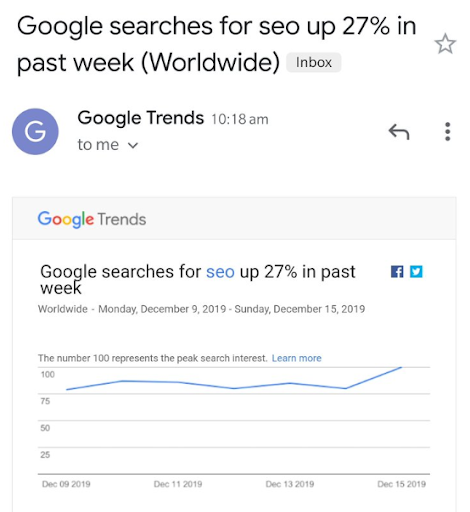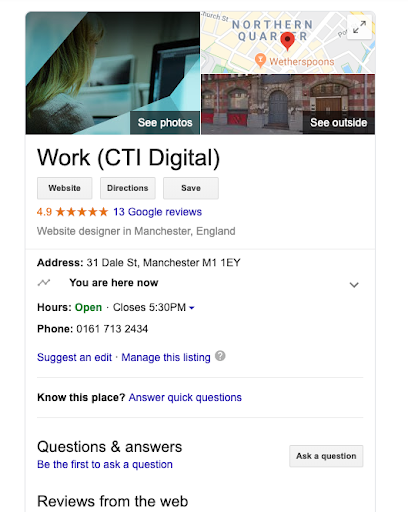2019 announced that ‘SEO is dead’. Zero-click results swarm Google search engine rankings. The BERT algorithm update will make SEO redundant. It seems like SEO will be dead and buried before the end of 2020... but is this really the case?
If anything, SEO continues to evolve and is becoming even more important than before.
A tweet from @cyrusShepard highlights that Google is facing more searches for ‘SEO’ than ever before. Businesses and individuals are increasingly looking for advice and information about SEO and how to implement it effectively.

SEO searches up 27% in December of 2019
So, what really is happening with SEO? And how can we make sure that we’re doing the right things to optimise your business for search in 2020?
Where we’ve been: SEO Headlines from 2019
In the second half of 2019, the launch of Google’s new BERT algorithm got nearly all the attention. BERT stands for Bidirectional Encoder Representations from Transformers. BERT aims to help search engines understand the nuance and context of words, to match search queries with the most helpful results. Naturally, in 2020 everyone will want to learn how to optimise for BERT.
But, rather than optimising for a single, specific algorithm, we need to focus on user-focused optimisation and the technical delivery of content. In short, that means reassessing how users search and aligning new and existing content optimisation with their behaviour.
However, we’re now suffering from Content Pollution. Searchers are drowning in vast quantities of similar content, which makes it difficult for your page to rank. To increase visibility in 2020, we need to produce content that is unique, well written and that highlights our expertise in the subject matter.
Where we’re going: How to optimise for search in 2020
There’s a lot to take in when considering SEO for the year ahead. As both users’ expectations and Google’s intelligence grow, SEO practices have to become more advanced. Here are a few key considerations to help your site stand out from the crowd:
Padlocks are even more important than ever: Secure your site with HTTPS
 Look for the tiny padlock at the beginning of the Google address bar
Look for the tiny padlock at the beginning of the Google address bar
Not having a secure (HTTPS) site will be fatal in 2020. Visitors expect Google to present secure websites, so Google’s Chrome browser explicitly warns visitors when a site is insecure. With 50% of all searches completed via Google Chrome, an insecure site risks alienating your business from both Google and your visitors.
Combatting Zero Clicks: Encourage searchers to click through to your site
Page 1 of Google search results has changed. Organic search results now compete for the user’s attention alongside paid ads, knowledge panels, maps, videos, featured snippets, and more. Searchers often find what they need directly on the search results page; if searchers do not click on any results, this is known as a ‘zero click search’. Over half of all searches now yield zero click results.
So what can we do to make your site stand out amongst thousands of immediate results? Here are some tips:
- Implement structured data. Google now displays structured data for 12% of all search queries. Encourage click-through by proving that you have the answer.
- Answer questions directly. Optimise your textual content to contain short, precise answers to the relevant search query you want to rank well for.
- Prioritise your content. Make sure that your page starts with a concise answer to the keyword(s) search term you are targeting.
There’s no magic solution to appear in featured snippets, but Google will likely pull through a clear, concise, specific response to a query.
Snippets are dominating more and more search clicks: Aim to dominate the search results page
Rich snippets and structured data stand out on search engine results pages (SERPs). It’s important that you look into adding this functionality to your site in 2020.
Structured data is a type of code in a specific format (generally Schema.org); it is written specifically for search engines to understand. Search engines read the code and use it to display search results in a much richer way. Rich results include knowledge graphs, information cards, videos, star ratings and product reviews.
For business brands in particular, Google uses structured data to populate the Knowledge Graph box that you see on the right hand side. If you have a business brand, you can edit the information which appears alongside the search listings for branded searches.
It’s not guaranteed that you will have a Knowledge Graph for your business but here are a few tips on how to get Google to show a Knowledge Graph for your business:
- Make sure you have a Google My Business listing
- Make sure you have relevant social media profiles (Facebook, Instagram, Twitter etc.) and that you use them regularly.
- Create a profile on Wikidata.org if you currently do not have one.
- Create a Wikipedia profile if you currently do not have one. (Note that you do not need a Wikipedia profile to gain a Knowledge Graph entry, but it can definitely help.)
- Implement organisation schema markup on your website (or, use person markup if you are doing this for an individual). Be sure to specify your logo, social profiles, Wikidata and your Wikipedia profile using the SameAs element.

Structured data for a business/location
Don’t Forget Alexa, Siri and Google, OK?!: Optimise for Voice Search
UK voice commerce is expected to be worth £3.5bn by 2022. We’re well on our way already, as 22% of current users have searched for local businesses and made a purchase using voice search. Is your website optimised for voice search?
In 2020 you should plan to complete the following:
- Undertake another round of keyword research. People type and speak very differently. You need to research keywords and search terms specifically, by device, to identify what people are asking voice search.
- Consider the full customer journey. Once you translated keyword research into content ideas, you’ll need to map relevant questions onto the various points of your customer journey. Creating voice-optimised content for different stages will ensure that you’re readily available and consistently helpful for all customer needs.
- Highlight structured data. If voice search devices pull directly from search results pages, you must feature as much information as possible in your listing. By incorporating structured data/rich snippet markup across all pages, you can aim to provide the most comprehensive results.
Discover more ways optimise for voice search on Search Engine Journal.
When was the last time you actually searched on your desktop outside of work?: Prioritise mobile experience
Studies show that 4 in 5 consumers conduct local searches using their mobile devices.
Mobile users engage with their devices at crucial moments and only for short periods. Their experiences need to be personalised, efficient and enjoyable in order to keep them engaged.
In line with Google’s mobile-first indexing, your website must follow simple mobile UX guidelines. Best practice user experience includes:
- Keeping URLs short
- Offering voice input
- Minimising forms
- Allowing permanent sign in
Just think: Google wants to keep users happy by giving them good results. As such, a positive mobile user experience will make your website more promising for users and search engines alike.
Need Answers? Try YouTube? Optimise for video search
Video search is still growing and by 2022, online videos will make up more than 82% of all consumer internet traffic — 15 times higher than it was in 2017.
What’s more, 57% of consumers say that videos gave them more confidence to purchase online. The consumer preference for video content explains why a website is 53 times more likely to reach the front page of Google if it includes video.
Youtube is already the second biggest search engine in the world but do you even have a Youtube account for your business?
If you are already using videos to promote your business you need to ask yourself the following questions:
- Are your videos for brand awareness or sales only? If so, are you using the right hosting platform for your videos?
- Do your videos have transcripts and captions? Remember: search engines can’t watch videos… but they can read text that explains the video content.
- Are your video thumbnail images engaging? Research from Wistia found that videos with carefully selected thumbnails receive a 30% higher play rate.
- Are you video titles and descriptions engaging? Just like webpages, videos should be described with keyword-rich detail.
Keeping Traffic Once You’ve Caught It: Prepare for Click Through Rates and Dwell Time to become ranking factors
2020 will see Click Through Rates (CTR) and dwell time become metrics that Google will focus on when deciding rankings.
Dwell time is the length of time a person spends looking at a webpage after they’ve clicked a link. Short dwell time, where users click straight back to search results, can indicate poor user experience, lack of engagement or irrelevant information. Dwell time can be affected by a myriad of factors, but, on the whole, great content and user experience will keep visitors engaged on your site and have a positive impact on dwell time.
Don’t just write for search crawlers, remember to create content that makes your audience happy.
Are you writing high quality content?: Meet Google’s EAT Guidelines.
In 2020, content is still as important as it ever was. But we don’t mean content for content’s sake. Aiming for sheer quantity of content is a common pitfall. Yes, long-form, comprehensive content is great to improve your search ranking and authority; yes, posting regularly will invigorate Google to keep crawling your site. But, ultimately, if you hire random freelancers to churn out content quickly, it’s likely that your content is not going to be anywhere near as successful as it should be.
You need either be an expert, know an expert, or go out and hire one. Google only wants to feature content that’s written by experts in their field. Google judges websites based on relevant, authoritative content. Your written content needs to be unique and adhere to Google’s Expertise, Authority, and Trust Guidelines.
Learn more about EAT and its rise as part of the 'Medic Update'.
Are your images as visible as they should be? Optimise your images for visual search
People are now using visual search more than ever. And this trend shows no signs of slowing. There have been more than 1 billion Google Lens searches and it’s growing. 62% of Generation Z and Millennial consumers want visual search more than any other feature. (source)
This popularity is obvious when you realise that visual search is great for the following:
- Shopping
- Directions
- Local Business Reviews
- And Loads more
To optimise for visual search, you need to apply suitable alternate text for all on-page and product images throughout your site. It also helps to have a consistent naming convention, so files are clearly labelled by describing the image.
Just think: a filing system of numbered images may make sense to your internal team, but won’t be quite so useful for someone searching for a “blue sofa”. Just as written content needs to cater for common search queries, image files do too.
So you’ve got traffic to your site, what do you do next?: SEO meets CRO
Currently, a whopping 33% of companies are investing little-to-no budget in CRO. This statistic is crazy when you consider that a typical website conversion rate is about 2.35% on average.
Too many companies are investing time and resources into driving organic traffic, but allowing users to bounce straight back to the search engine without converting. Contrastingly, the top 10% of companies using CRO are seeing between 3 and 5 times higher conversion rates than the industry average.
2020 will see SEO and CRO (Conversion Rate Optimisation) work together even more closely.
SEO projects cannot afford to focus on organic traffic alone; we must also minimise bounce rate, increase pages per session and delight the user towards a conversion. Ultimately, Google is more human than it has ever been and increasingly dedicated to providing a positive user experience. So 2020 is the year to optimise for search and to optimise for an extraordinary user experience.
Expert SEO Advice
To discuss any of our SEO insights in further detail, or to learn more about combining SEO, CRO and UX services, get in touch with our team.
Additional References
https://backlinko.com/seo-this-year
https://www.cardinaldigitalmarketing.com/blog/12-seo-trends-for-2020-that-you-need-to-know/
https://www.searchenginejournal.com/2020-seo-trends/338697/
https://www.insivia.com/28-video-stats-2018/
https://www.wordstream.com/blog/ws/2017/08/02/conversion-rate-statistics








